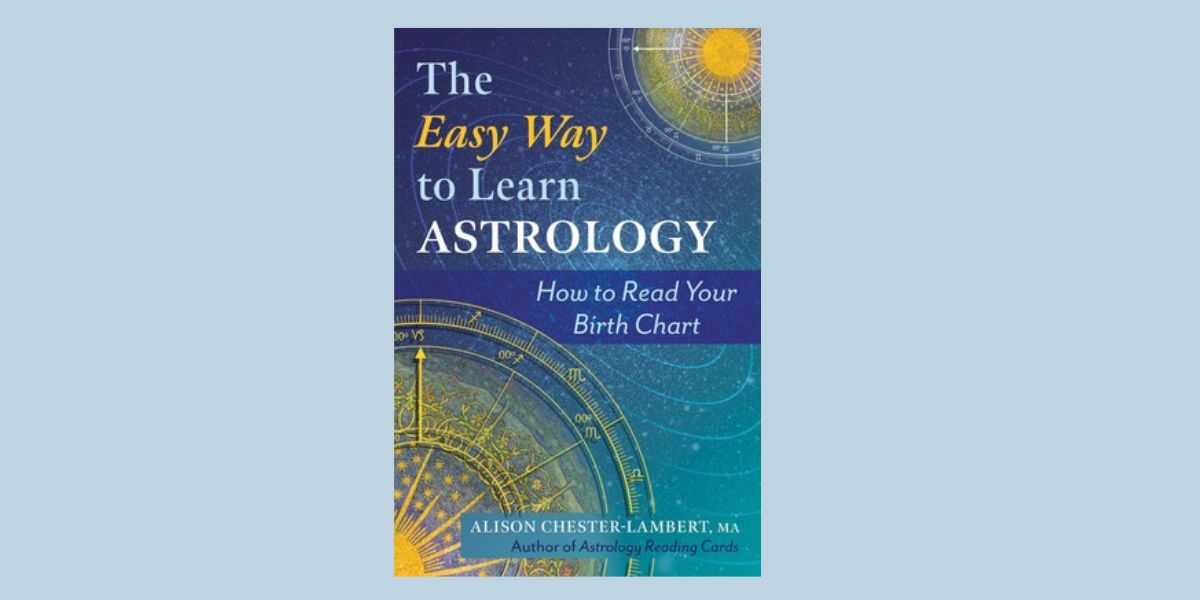
The Easy Way to Learn Astrology: How to Read Your Birth Chart, by Alison Chester-Lambert
Findhorn Press, 9798888500392, 175 pages, June 2024
As a student of astrology for almost twenty years, I was interested to learn about Alison Chester-Lambert’s teaching style and process, which she calls The Easy Way to Learn Astrology. Within six chapters, Chester-Lambert breaks down the complex topic of astrology and offers the reader access to a Facebook group and YouTube videos for additional learning aids.
Chester-Lambert first became interested in astrology after reading Linda Goodman’s Sun Signs in the 1970s. She studied astrology at the Faculty of Astrology in London, as well as The Center for Psychological Astrology at Regents College. Later, she earned a master’s degree and took advanced studies in psychology, astrology, and astronomy. After working for over two years with a live, call-in horoscope service, she relocated from London to Tamsworth and began writing columns, doing readings, and teaching. She has founded and runs the Midlands School of Astrology and travels and lectures all over the world. Chester-Lambert has written three other books and published two decks of cards. You can learn more about her at her website.
After a brief introduction of polarities, including masculine/feminine, Chester-Lambert presents one of the most complete charts of the zodiac signs I have ever encountered. In one, easy-to-read table, she shares the yin and yang of the signs, as well as how the elements of fire, earth, air, and water interplay with the twelve signs. She also talks briefly about sun signs and how well-known astrologers and published horoscopes focus on this one aspect of the natal chart:
“So, what does Sun Sign mean? Before I answer that, I must explain that we have more than one astrology. Many astrologies. Plural. Lots of them.”1
Chester-Lambert goes on to say that each person has a natal chart with twelve houses and twelve signs and that to understand astrology, you may want to focus on more than just your sun sign. This is an important distinction since you will “want to know the psychological meaning of each of the signs and houses…. Just in case you were tempted to go straight to the signs you know and ignore the rest, let me explain that we all have every sign in our birth charts.”2
Next, Chester-Lambert takes us through the four elements of fire, earth, air, and water. She provides keywords for the four elements and then goes into each element, including the three zodiac signs that hold that energy. She then takes us on a deep dive into each zodiac sign and we learn the psychological components, qualities, and characteristics of each sign.
However, I want to point out that she goes into much more depth for each of the four elements than any other book or instructor I’ve encountered. It’s so interesting and I can see how this knowledge forms the foundation for your true understanding of astrology and the natal wheel. She spends almost 100 pages on the elements and signs.
In the last part of her book, Chester-Lambert shares the modalities (cardinal, fixed, and mutable), does a brief review of the elements, and then discusses the importance of opposite signs on the natal chart. She follows this with a discussion of the houses and how the zodiac signs travel around the wheel in counterclockwise fashion, always in the same order. I love how she relates each house to an element and a modality and provides a chart for visual reference.
Each chapter, as well as groups of related chapters, end with a review of the materia– just as you would do in a class. It is so helpful! She also gives a sample reading that is based on a woman’s query. Then she discussed The Cross, which is comprised of the AC (Rising Sign), DC (Descendant), MC (Midheaven) and IC (Imum Coeli) and the importance of the four quadrants that the cross designates. Lastly, she provides us with another sample reading of a birth chart, before telling us that we are now ready to read our own chart.
Chester-Lambert adds resources for creating your own chart online, a complete bibliography, and a detailed Index. Not only does she refer the reader to a website for getting a natal chart, but she also gives detailed instructions for creating the custom chart. Very few authors do this.
The Easy Way to Learn Astrology would be perfect for anyone who wants to study astrology, from the total newbie to a more seasoned student. I learned so much more about the psychological qualities of each element and sign, as well as the qualities of the houses on the natal wheel. I plan to take a fresh look at my natal chart and review each sign, element, and house. The information I learned about fire signs alone has given me new clues as to why I act the way I do and how to support myself and my energy levels. I will also share this new information with my clients.

PJ Spur is an author, intuitive, spiritual mentor, astrologer, and hypnotist. She does tarot & oracle card readings, natal chart readings, grief coaching, and relationship healing. She also has hosted a weekly “Coffee & Cards” event with her Soul Compass Community for the past four years. Her book Navigating Grief with Grace is available on Amazon. Learn more at www.dearpj.com
